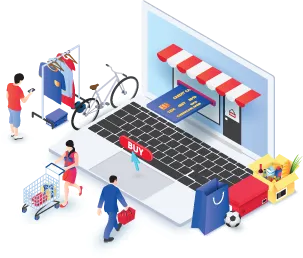

Posted in Digital Commerce, Digital Transformation
September 14, 2021
Engineered ecommerce: A digital transformation methodology.
The foundation for adaptable solutions that solve today's complex digital business pains.

ENGINEERED
/ˌenjəˈni(ə)rd/
“Skillfully and deliberately arranged rather than arising naturally or spontaneously.”
We use the Oxford English Dictionary’s definition for the word “engineered” to describe how online retailers of the future will operate using engineered ecommerce. Global research institutes, such as Gartner, already indicate that engineered ecommerce is not only the way of the future but that it’s already beginning to happen.
This whitepaper is a journey into the future of digital business through engineered ecommerce. Within these pages, you’ll find several unique examples of how engineered ecommerce eliminates common business pains and how each progressive step forward is beneficial to not only individual departments but the business as a whole. When realized, engineered ecommerce is capable of transforming today’s online retailers into the powerhouses of tomorrow.
What is our methodology, and what makes it different?
But what makes our methodology different? To explain, let’s first establish some background. At the beginning of online retail, businesses built custom, in-house software solutions to conduct their business online. While extremely flexible, creating a custom platform and all the components and integrations required is costly and complex. The expense and technical challenge are prohibitive to many small and medium-sized businesses, making this a solution primarily used by enterprise-level companies.
Then along came SaaS (software as a service). Businesses jumped on the opportunity to take the high cost and complexity out of the equation by giving online retailers a managed platform they simply just need to sign up for and use. Online retailers now have access to many SaaS platforms for ecommerce, marketing, customer service, analytics, and much more.
Today, there is no single platform capable of everything an online retailer needs. Instead, these businesses rely on an ever-changing landscape of individual pieces — a mix of SaaS, open source and custom software systems. When you stop to take inventory, dozens of different platforms typically make up the toolkit of a single business. In this situation, it’s nearly impossible to keep track of all of these systems, and that in itself leads to a new set of business problems.
This is what makes our methodology different. We designed this methodology to take a critical look at the big picture. It seeks to understand the purpose of all platforms used, then skillfully and deliberately arrange them in ways that increase operational efficiencies, ultimately creating a unified ecommerce architecture tailored to the business. This methodology isn’t just a connector or integration; it’s architecture.
A methodology that solves digital business pains.
While arranging and connecting business platforms into a unified architecture is the end goal, our methodology is explicitly made to solve today's digital business technology pains.
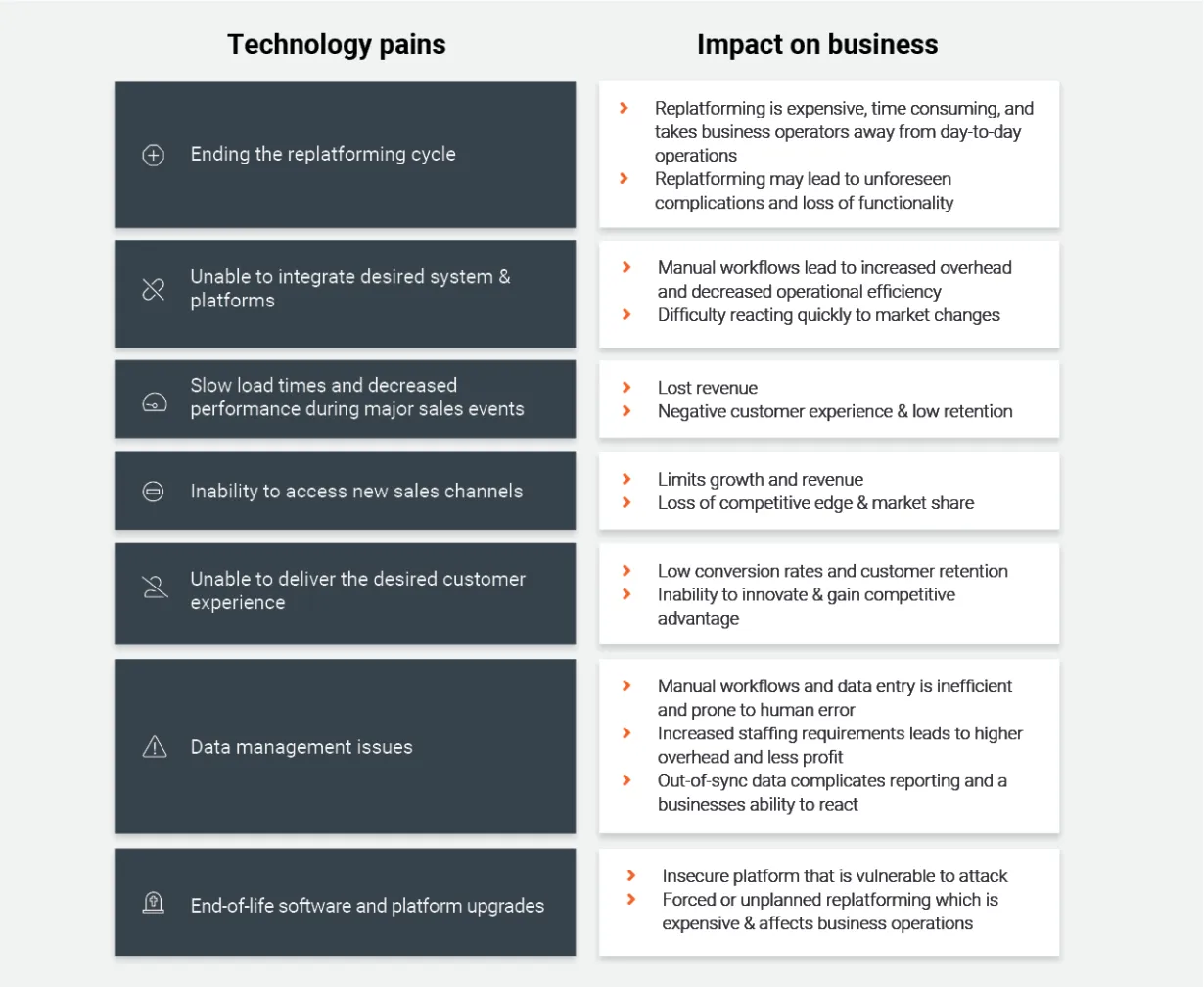
As you can see, these common pains have a significant impact on business. Solving these pains will help a business reach new levels.
Ending the replatforming cycle.
Online retailers have been led to believe that they have two options for development; proprietary (buy) or custom (build). While many companies can choose one or the other and live there comfortably early in their lifecycle, most established retailers don’t fit nicely into either end. These businesses feel growth and workflow challenges related to frameworks that are either too rigid (proprietary) or too expensive and complex to maintain (custom). They end up going around in circles, searching for new solutions.
The effect of this struggle is that these businesses enter a replatforming cycle, where they believe changing their ecommerce platform will solve their pains. Unfortunately, without looking at the larger picture, they will most likely be in the same replatforming situation again in 2 to 5 years. A report by Internet Retailer titled 2019 Leading Vendors to the Top 1000 E-retailers reported that “49% of retailers say their ecommerce platform is their top budgeted priority over the next year.” How many of these businesses are entering a replatforming cycle that they will repeat? We don’t know, to tell the absolute truth, but experience tells us it’s likely many.
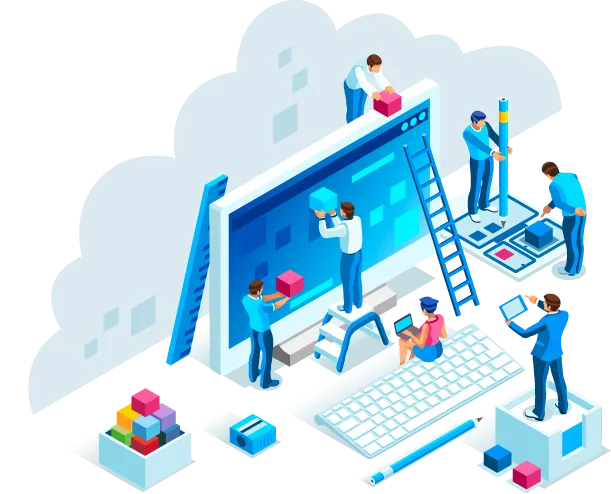
An open ecommerce framework based on open source technology is at the heart of our methodology. It is designed to address these common platform pitfalls, workflow challenges and inevitable replatforming cycles. It’s a framework that takes the best of both sides of the spectrum, settling somewhere in the middle and is driven by business requirements. It has ample core functionality so that businesses aren’t reinventing the wheel but is completely customizable, ensuring unique business edge-cases can be met. It’s extendable, supporting innovation and the development of new features, custom functionality, and integrations. Finally, it’s built upon widely recognized and modern programming methods and coding standards, making onboarding development teams, either in-house or third-party, much more manageable. An open ecommerce framework is meant to be the middleware that connects all of the components within a business’s ecommerce architecture together — a mix of proprietary, custom, and open source — as much or as little as the company requires.
Unable to integrate desired system & platforms (including third-party, legacy and custom/homebrew).
An API (application programming interface) is the term used to describe the communication protocol that different platforms use to send data between them. So, for example, when a customer completes the checkout process, a checkout API can send information about the customer and transaction to other systems, like fulfillment and accounting. Another typical API example is for taxes. Tax calculation in countries like the United States is highly complex. Instead of maintaining the list of taxes in-house, integrations with services like Avalara and TaxJar have APIs that software can pull from always to use the most up-to-date tax information. For a digital business, integrations and APIs are used everywhere.
“Through 2021, 85% of the effort and cost involved in a digital experience platform (DXP) program will be spent on integrations with internal and external systems, including the DXP’s out, built-in capabilities.” - Gartner, “Don’t Wreck Digital Engagement With Bad Deployment Decisions for Your Digital Experience Platform,” 31 July 2019, Gene Phifer.
But the availability of an integration or API isn’t always guaranteed. Proprietary (buy) ecommerce platforms control their APIs and may or may not give software developers enough access to make an integration that relies upon them. Many integrations will already exist, especially between large, common and partner platforms, but they still might not be complete. Custom integrations with legacy or custom/homebrew systems may not even be possible. It all depends on what APIs are made available on both sides. Businesses using proprietary platforms most likely do not have any control over the development roadmap for APIs, integrations, or the quality of the final product.
In contrast, a fully custom (build) ecommerce platform can have all the APIs and integrations it wants limited only by the business’s ability to make it happen through investment and development capabilities. However, building all of the APIs and integrations alongside an entire ecommerce framework is a monumental task that cannot be understated. The associated cost is enormous, and gaining the expert knowledge required to architect and build it is not quickly done.
Our methodology, utilizing an open framework with an open set of APIs, gives businesses the ability to choose the platforms they use and the required integrations. It guarantees that a company can integrate with other systems, including proprietary, open source, legacy and custom/homebrew, through the use of already established APIs for standard functions such as account authentication, database management, form interaction, page rendering, cart manipulation, checkout handling, order management, and much more. This is essential for business automation and streamlining workflows. Building all of these APIs and the associated integrations in-house would be incredibly time-consuming and expensive, but building on top and extending them is much more reasonable. Open APIs and integrations can be added to and modified at will, freeing businesses to only invest in building additional APIs and integrations where it makes sense. Of course, there is no guarantee that the platforms and systems a business is attempting to connect with will have an API available to integrate with. In these instances and the whole point of viewing your ecommerce architecture as a whole, the platform or system in question could be swapped out with something better suited to the requirements of the business.
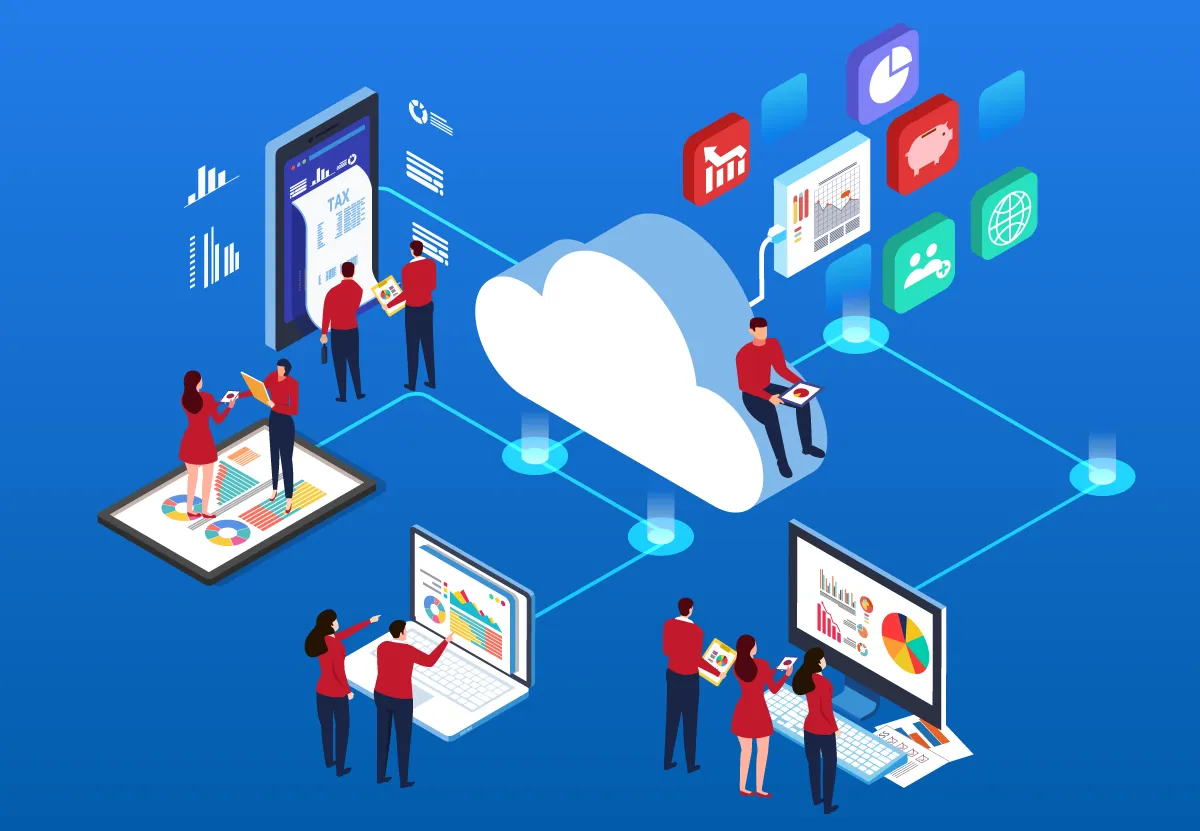
Slow load times and decreased performance during major sales events.
Server architecture is a critical aspect of site performance yet is easily overlooked. It’s the background hosting and management of all of the elements required to run a large ecommerce website tick; database(s), file storage, load balancing, caching, traffic monitoring, bandwidth, backups, etc. Without the correct server architecture in place, load times increase, and customer experience is negatively impacted. Significant sales events like Black Friday or product launches can strain server configuration to the point of failure.
Server architecture may or may not be managed by the business. With proprietary (buy) platforms, servers are typically managed by the service provider. This hands-off approach is beneficial to online retailers who do not have the budget or expertise to manage the servers independently. Startups and small businesses tend to gravitate to this type of solution. Of course, if the service is excellent, the business is in good hands. If not, the company can suffer. Corporations under a hosted package are tied to the provider and have little to no control over the server architecture.
On the other hand, a business managing its own server architecture, either internally or through a third party, has much more flexibility. These businesses can tweak server configurations for their specific needs and implement unique server-level tooling that they might not have otherwise. Of course, the tradeoff here is managing servers comes with additional expense because someone, either internally or through a third party, must be involved. This additional expense may be worthwhile in gaining that ideal performance benchmark to satisfy the customer experience.
Our methodology takes a hard look at business technology and performance requirements and suggests the best course of action to take. However, know that an open ecommerce framework isn’t a one-size-fits-all approach and thus will most likely require a managed server solution. If this is the case, the process that arrives at this conclusion makes the reasoning crystal clear and provides the configuration, optimization, and support requirements to maximize blazing-fast site speed for all customers regardless of the site’s amount of traffic.
Inability to access new sales channels.
Accessing new sales channels is instrumental in growing a digital business and reaching new customers, but it isn’t always straightforward. Customers will most likely access a business’s products through traditional formats such as their website on their computer or mobile device. Still, many customers will choose to shop in other ways. Online marketplaces (Amazon, eBay, Alibaba, etc.) and other third-party distribution channels see a massive amount of customer traffic that a business may want to access. B2B, trade shows, kiosks, resellers, dropshipping and volume-based channels are other channels that may require an entirely different or unique sales flow. Then there are non-traditional channels emerging such as IoT (internet of things) and voice assistance (Google Home, Alexa, Siri, etc.) that break the mould of the traditional interface. Whatever the sales channel looks like, having the flexibility to access it might not be critical right now, but adapting to new and changing markets may be necessary for the future.
“In order for digital commerce to achieve scale and leverage IT expenditure, organizations need to focus on transforming the business with product and service innovations, differentiated customer experience, and use of Internet of Things (IoT) technologies. This will help organizations generate growth from new product offerings, new ways of selling, new sources of revenue and new business models.” - Gartner, "Survey Analysis: Organizations Need to Improve the Customer Experience to Fully Exploit Digital Commerce," 4 February 2019, Penny Gillespie.
In a traditional business website setting, the ecommerce platform typically provides the website frontend (the presentation layer that customers interact with). So, how then does a business get its product information and possibly a whole new user interface to other sales channels separate from the ecommerce platform? Doing so requires that the ecommerce platform and associated components are capable of running decoupled from the front end. Decoupled is also commonly referred to as running headless. To do this, APIs are once again used to push and pull data between the digital ecommerce architecture and whatever frontend interface is being used, such as a phone app, third-party marketplace or reseller, kiosk, voice assistant, etc. Figure 2 shows a visual representation of a decoupled or headless digital ecommerce architecture.
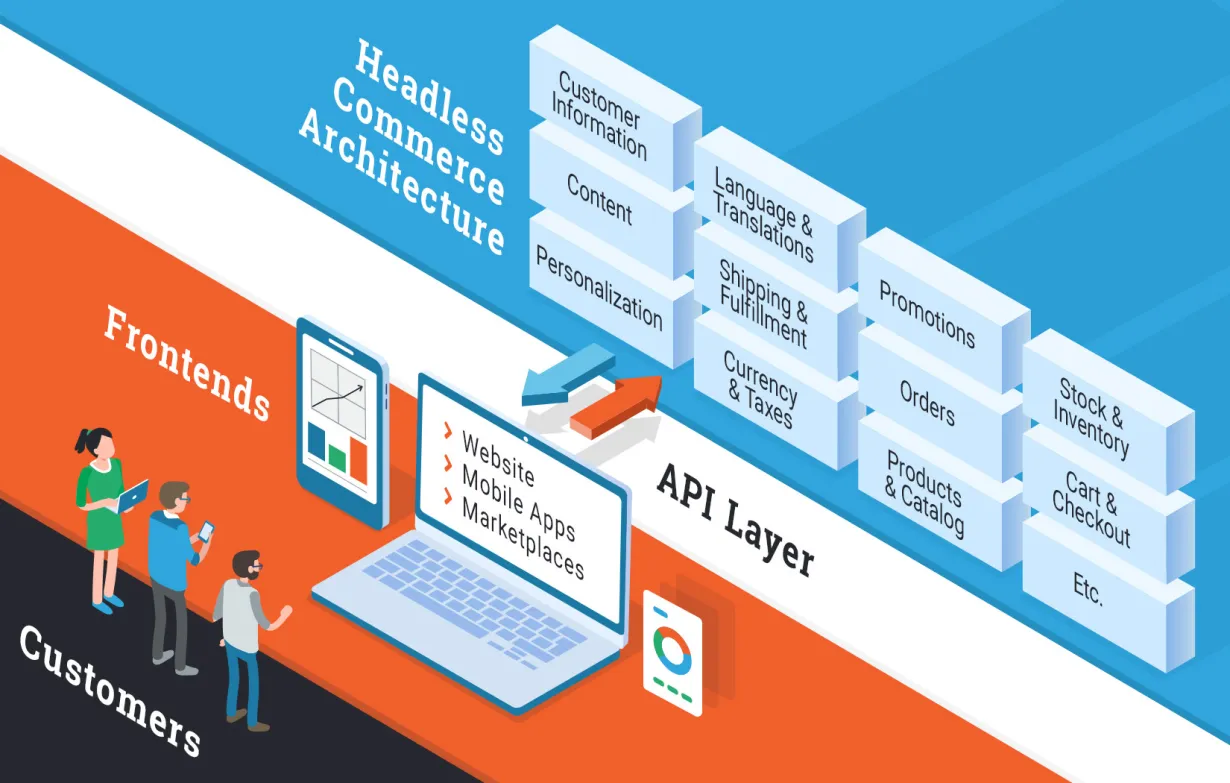
Figure 2: Example of the Decoupled Experience Layer
Our methodology uses the open ecommerce framework and its APIs to provide the foundation for opening up new sales channels and business models. From here, opening new sales channels may be as simple as installing and configuring an already created integration. For anything else, an integration can be built or new frontend technology adopted to provide the connections and interfaces needed to expand the business in new ways. Having the right ecommerce architecture in place provides the capability for unlimited potential and business growth.
Unable to deliver the desired customer experience.
Content delivery in the form of blogs and articles has been around for a long time, and delivering that content in many ways is not uncommon. Think website blog feeds, email newsletters, RSS feeds, newsgroups, etc. But, combining content with ecommerce functionality is still a new battleground for engaging customers and selling products in new experience-driven ways. Businesses are exploring content capabilities, and buzzwords like personalization are now a part of everyday discussions. The goal is the same for all, provide a unique and personal customer experience to gain loyalty and drive sales.
“The rise of experience-driven commerce means that this traditional buying funnel is no longer the only journey. Richer product experiences, narrative-driven, social, or lifestyle-oriented journeys can better drive conversion for some product types. Integration to social networks, home digital devices and other touchpoints create new journeys that require interoperation with the digital commerce platform.” - Gartner, "Harness the Core Capabilities of a Digital Commerce Platform,” 4 September 2019, Mike Lowndes, Christina Klock.
How much integration of content and commerce is needed all depends on the product being sold. For example, a large marketplace like Amazon, full of a variety of products, uses very little extra content on its pages. You might see a bit of content in the form of category images or a topical message at the top of the page, but mostly the site uses data gathered from a customer’s browsing history to personalize product suggestions. This type of personalization and predictive programming is becoming increasingly popular, especially for a site like Amazon where there are so many product categories to view. It just makes sense.
Now switch gears and consider a niche product like Fitbit. Fitbit only has a handful of products, and they are all centred around fitness tracking. The content requirements for each Fitbit product are so much more than just showing a product image, price, and colour variations. They do that, but Fitbit also strives to create a personal buying experience around an idea that their customers share; their customers want to feel active and healthy while sporting a unique personal accessory. To create this experience, Fitbit uses rich, activity-centred media, highlights integration capability with other personal apps, focuses on how their activity trackers fit into daily life and show customers how they can customize their Fitbit through accessories, making it their own. The experience is what creates a desire to buy a Fitbit and drive sales. The actual device specifications are secondary to the experience.
"Despite the need to deliver great customer experiences, a large majority of survey respondents report poor performance in this area. Delivery is not easy, and most organizations rate themselves low in their ability to do so." - Gartner, "Survey Analysis: Organizations Need to Improve the Customer Experience to Fully Exploit Digital Commerce," 4 February 2019, Penny Gillespie.
But delivering the desired customer experience across all sales channels is hard. Many proprietary ecommerce platforms simply lack sufficient content-creation and/or personalization capabilities. Third-party platforms and integrations may help some, but most of these platforms are siloed and not integrated with the entire system as well as they could be. With one problem solved, new problems arise, complicating other department efforts such as marketing and customer service.
Whether a business is like Amazon or Fitbit, implementing the desired customer experience through a content strategy, personalization, UX design, or any other means requires the same level of foresight and big picture understanding as anything else within a digital business’s ecommerce architecture. Our methodology is the mechanism to make it click. It provides a holistic approach through the understanding of business and department workflows and processes, the technology they use, and their desired customer experience outcomes to effectively market their brand and products on all channels.
Data management issues.
Another critical piece in engineered ecommerce is managing the vast amounts of data captured and used daily by the many platforms that make up a digital business’s ecommerce architecture. But the reality is that the data within many platforms is siloed and not shared. In this case, someone needs to manually gather that data and share it, which can be a slow process, especially if people are busy (which they likely are).
Data management issues typically emerge as a business grows. Manual data entry workflows that may have once been fine become increasingly time-consuming as the same process must be used whether the business scales from 2x to 100x. Without a strategy to manage this data automatically, additional personnel must be added to control it instead. Not only does this affect the business’s bottom line, but this practice is prone to error and requires greater oversight.
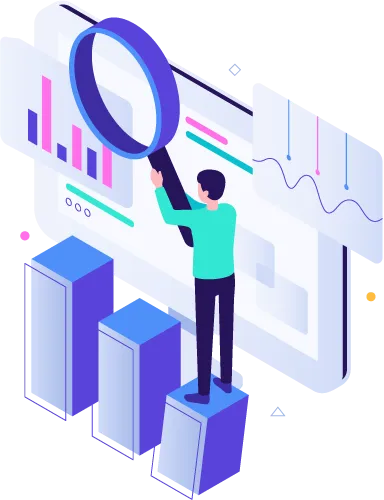
Disconnected data is also a cross-department issue. Purchase and sales information must be shared with accounting, payment and checkout details must be shared with fulfillment, product details must be shared with any third-party marketplaces, customer details must be shared with marketing, inventory and stock levels must be shared with supply management, and the list goes on. Whether it’s realized or not, the flow of data is the lifeblood of digital business.
Our methodology, utilizing an open ecommerce framework and open APIs, provides the solution to data management. It involves mapping exactly where business data is being generated, what platforms contain what data, how it’s stored, how it’s used, and, most importantly, whether or not it can be shared. Mapping the flow of data quickly shows where workflow efficiencies can be made, where system automation makes sense, and where opportunities lay. From there, a data management strategy can be formulated that works towards connecting and improving the flow of data through platform integrations and workflow automation. Once realized, this strategy frees up an incredible amount of time, improves the bottom line, enables business scalability, promotes marketing capabilities, and supports customer experience and service.
End-of-life software and platform upgrades.

Many ecommerce related platforms and software, whether it has to do with your website, marketing, payment, inventory, fulfillment, and more, may eventually reach end-of-life (EOL). EOL means that the vendor or whoever is actively creating, supporting and marketing the platform will cease to do so from a given point onwards. Often, the decision to announce a platform EOL is because the next version is being released. Sometimes, EOL can be because a platform is being shut down entirely. In either case, EOL can have a significant impact and potentially leave a business in a difficult position.
All of the elements of our methodology are working towards a future-proof design where the big picture is understood, and the ecommerce architecture of a digital business is skillfully and deliberately arranged to meet its needs. This doesn’t mean that the ecommerce architecture won’t ever change; it means that the design of the system is done in a way that allows for change if and when change is required. If a new platform is needed or an old one must be removed or swapped for any reason, including EOL or version upgrades, any pain of doing so is mitigated as much as possible through the understanding of how everything is connected and what areas of the business will be impacted. In a constantly changing world of digital business, the future of digital business requires a design that is adaptable and agile to meet the needs of both business and consumer.
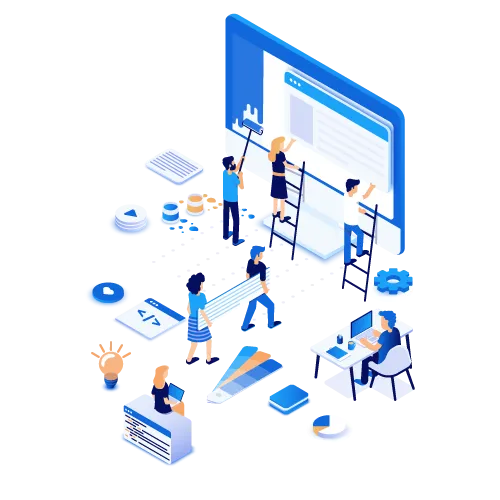
Achieving ecommerce success through our engineered ecommerce methodology.
Our methodology is an incremental process that won’t happen overnight. While it can be transformative, by no means must the business be rebuilt from the ground up. Much of what this methodology is designed to do is simply finding and closing gaps, automating manual workflows, integrating systems, and enhancing the user experience of both staff and customers.
Our methodology starts with a series of possible exercises meant to review and evaluate the current state of the business, its capabilities, its technology, its brand, and the people behind it. From there, meaningful change can be prioritized. Throughout the process, businesses may find that leaning on the expertise of digital commerce consultants is beneficial. Though not necessary, these experts will outline a method, provide guidance, and assist internal teams who may not have the depth of experience needed to complete the required steps.
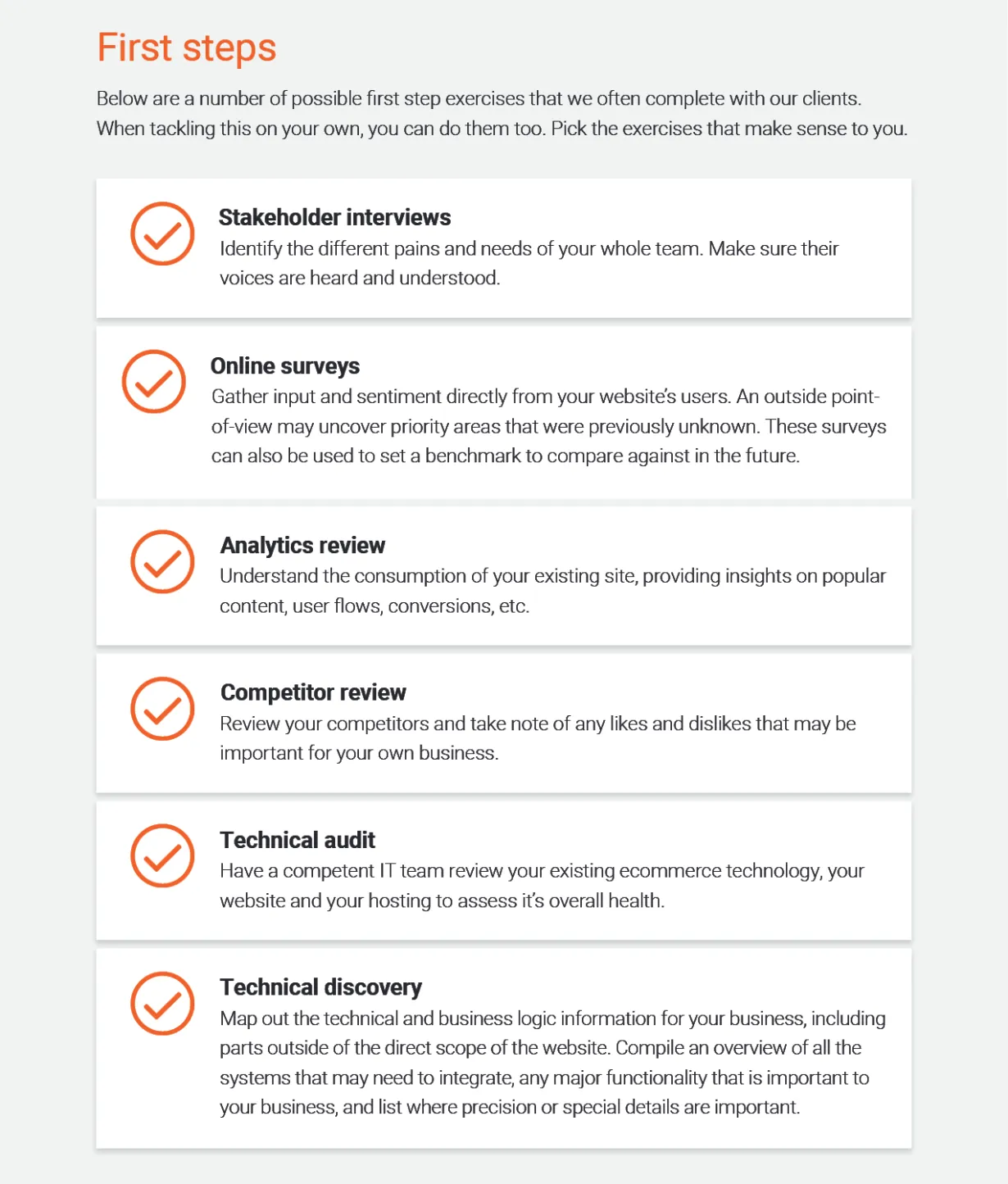
The future of digital business
With the implementation of our engineered ecommerce methodology underway, a business will start to realize the benefits of the bright future ahead. Resources and capital freed can be repurposed to implement new business initiatives, open sales channels, innovate the customer experience, and scale the business to new levels. The future of digital business looks bright indeed.
"We wanted to begin by protecting our revenue streams overall and those associated with our digital platform. And there’s no doubt in our minds that the work Acro has done for us has provided that protection and has enabled us to grow in a couple of dimensions: one, we’re seeing growth in terms of revenue; we’re seeing growth in terms of new customer acquisition; we’re seeing growth in average order size, and we’re seeing growth indicators in areas of a satisfying customer experience." - Gregory M. Sottile, Ph.D., Director of Sales & Marketing, USI Laminate.



